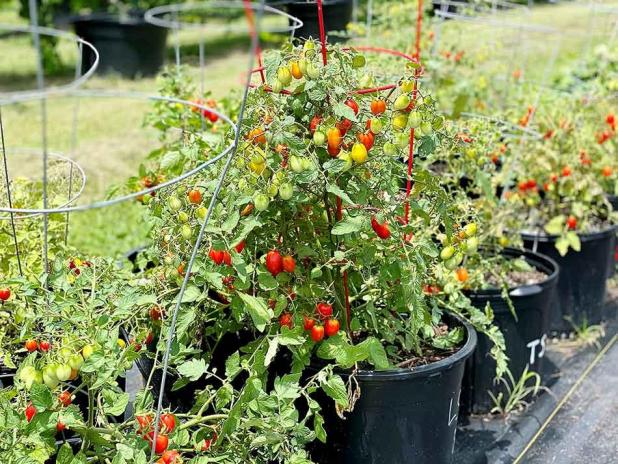
Containers 10 gallons and larger are great for vegetable production. A good slow-release fertilizer and use of liquid fertilizer when needed will help produce the most flowers and fruit.
—LSU AgCenter/Heather Kirk-Ballard
Get It Growing: Beat rain with container-grown vegetables
With the historic rains this spring and summer, we’ve doubled — and in some cases tripled — the average for several places in Louisiana. It is no wonder some of our plants, yards and gardens are suffering. We’ve already reached 78% of the annual amount of rain, with another half a year to go.
With that rain comes many issues for all sorts of plants, especially our vegetables. If you planted in the ground with saturated soils and poor drainage, you may have already lost your tomatoes, peppers and other vegetables. Even in raised beds like the ones I use at my home, my tomatoes are toast.
One thing we can do to be more fruitful (forgive the pun) with our vegetable plants is to try container gardening. I’ve seen many homeowners defeated and frustrated by diseases that affect vegetable plants who have turned to containers as a solution. When considering diseases of vegetables, the list is long, and one or more culprits such as bacteria, fungus, fungal-like microorganisms and viruses can cause them.
Some of the most common in vegetables are fungal diseases such as powdery mildew, downy mildew, early blight, Southern blight, late blight, phytophthora root rot and damping off. There also are bacteria-related diseases such as bacterial spot, leaf spot, Southern bacterial wilt and diseases caused by viruses. Therefore, if you like a challenge, vegetables are your crop.
Homeowners and small-scale vegetables producers alike have been rising to the challenge of the endless rain and diseases encouraged by wet and hot conditions by switching to container-grown vegetables. University studies here at the LSU AgCenter conducted by myself and vegetable specialist Kiki Fontenot are showing promising results (not yet published).
There are a few key considerations to be successful.
First, use an appropriate-sized container. Because vegetables are seasonal, you do not need a huge container, but don’t go smaller than a 10-gallon container. For larger plants, a 15- to 20-gallon planter is ideal with proper drainage. This is important. Be sure to check containers for drainage holes. Most come pre-drilled, but not all do.
Next, the soilless media or potting soil is important. You want one that is just the right balance of good drainage, moisture retention and fertility. Media and potting soils that contain slow-release fertilizers and micronutrients are ideal for the best production.
If the media you have chosen does not include any fertilizer, it is a good idea to incorporate a slow-release granular fertilizer into the soil mix. A general all-purpose liquid fertilizer also can be supplemented every seven to 14 days as needed by the plants.
One of the most beneficial things you can do is to place containers on a barrier such as ground cloth. The cloth helps prevent weeds from growing up into the containers and creates a barrier between the pots and bare soil. With proper drainage of the ground beneath, this could help lower the incidence of soil-borne diseases in vegetables. We have seen some success with this in our studies.
Lastly, provide proper water or irrigation to the plants. Watering at the soil line will help discourage leaf spots, downy and powdery mildews in addition to rusts and other foliar diseases. A drip irrigation system set on a timer takes the hassle out of the routine of watering, as plants in the heat of summer compared to the rest of the year will likely need daily or every-other-day watering.
Set automatic timers to turn on in the early morning hours around 6 to 8 a.m. for several minutes depending on the gallons per minute output of the irrigation emitters. It is important not to waste water or leach out more nutrients then necessary.
Be sure plants get a minimum of six to eight hours of sun and that there are plenty of pollinators around, and you are sure to have a successful vegetable harvest. By planting flowering plants nearby, you will draw in more pollinators, or you can pollinate by hand.
Healthy vegetables can be grown in containers in this simple way and enjoyed at your dinner table or right off of the plant.
